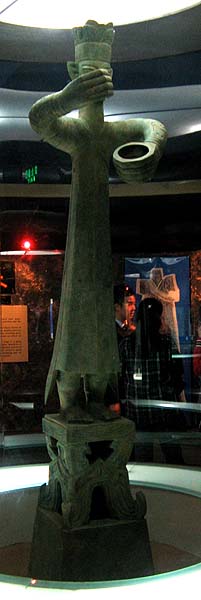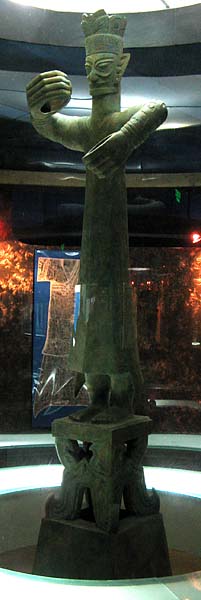


Large Standing Figure
Sanxingdui Museum



|
Large Standing FigureSanxingdui Museum |
This remarkable bronze statue, 2.6m (8.5ft) tall including its base, is the poster child (and traveling ambassador) for Sanxingdui. It is literally unique, the only complete figure of its size and kind that is currently known. The figure is attenuated but powerful, barefoot, and male. It stands rigidly upon a pedestal, and originally held an elephant tusk, a pile of which were found buried on site. It wears three layers of robes, the outermost of which is elaborately decorated with shallow designs that have been interpreted as dragon motifs. Its crown, or headdress, bears a putative sun design.
Its dragon robe, sun crown, and pedestal have suggested to many scholars that the figure is royal. It could also be interpreted as a god, a priest-king, or even a god-king. He might have been offering an elephant tusk to the gods, or carrying it as a symbol of authority, or both. His bare feet could have ritual significance. When the statue was new, it would have gleamed with the golden luster of freshly-worked bronze.
Although no other large complete figures like this one have been found, fifty-seven similar heads (without bodies) were excavated. They are thought to have been mounted on poles, robed in cloth, and arranged with this figure inside some kind of ritual precinct. The three photos, above, illustrate how the figure may have been approached; left photo, the face is obscured; most likely it was arranged in the precinct so as to be seen frontally (center photo) or from the left side of the face (right photo). There appears to be some damage to the right eye of the face.
One possible interpretation, although it cannot be proven given the present incomplete state of our knowledge, is that these impressive figures could represent divine ancestor-kings, holding the tusks of sacred authority, whose images were displayed and revered in a special ritual precinct. Their cult would have served to legitimize the heaven-derived lineage of the early Bronze Age kings of Sanxingdui. When that lineage ended, due to war or political changes, their ritual artifacts were broken up and buried, and leadership passed to successor towns like Jinsha. Admittedly, this does not explain why there were two (not one; see previous page) acts of ritual decommissioning at Sanxingdui. It is possible to imagine, although this is pure speculation, an interval of transition between the burial at Pit 1 and the burial at Pit 2, during which political power might have gradually devolved from Sanxingdui to other localities.
In later times, the Sichuan region developed into the kingdoms of Shu and Ba (9th century BC); the latter kingdoms were eventually defeated and absorbed into the expanding Qin empire in 221 BC.

|

|

|